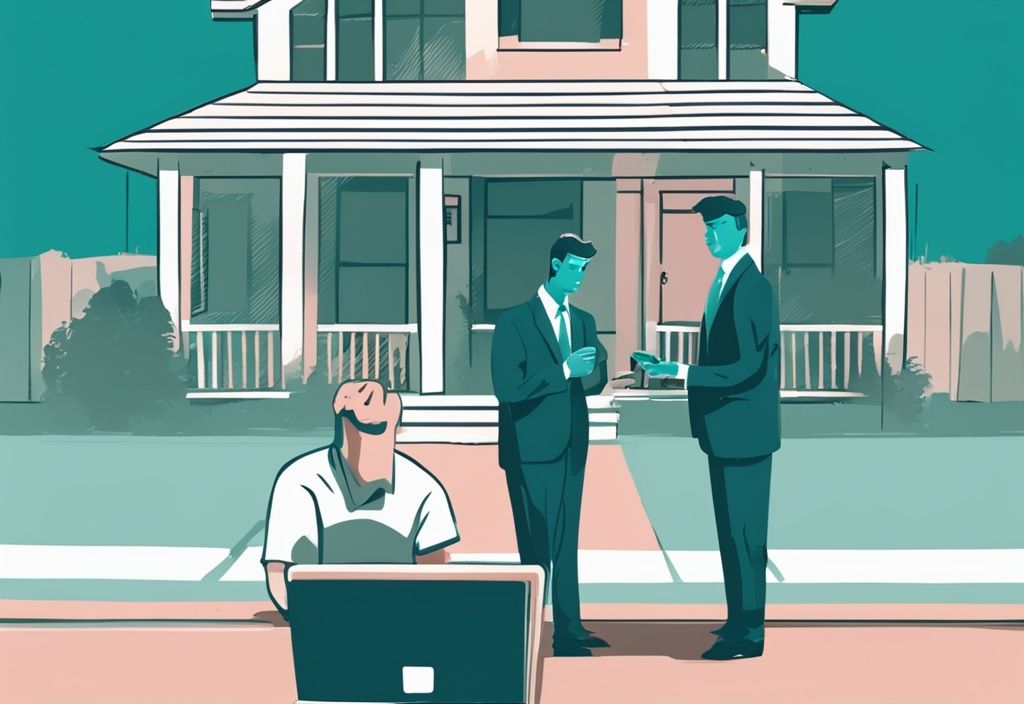“Pending”. Now that’s a word you hear a lot in the real estate world. But what does it really mean? For anyone diving into the property market, understanding this term is like having the secret code to decipher a treasure map. Don’t worry, I’ve got you covered.
We’ll unpack the concept of “pending” in real estate transactions, simplifying it into digestible chunks. Through exploring the what, why, and how behind this key status, you’ll be steering clear of pitfalls and sailing straight into rewarding opportunities. Essentially, this little term packs a punch. It’s like the thread guiding you through the labyrinth of property sales.
With these insights, whether you’re buying or selling, you’ll become a master navigator of your property journey feeling not just informed but truly empowered. Now, let’s dive in!
Definition of Pending in Real Estate
Pending status in real estate signifies that a home sale is currently in progress but not yet complete. This status indicates that a potential buyer has submitted an offer on a home, and the seller has accepted it. When a property is listed as pending, it typically means that all contingencies, such as inspections, appraisals, and other conditions specified in the sales contract, have been met. Therefore, the buyer is in the process of finalizing the sale and preparing to close on the property.
A pending status signals a signed contract between the buyer and the seller, which is progressing towards completion but has not yet been finalized. Subsequently, the property is removed from the active listings on the local multiple listing service (MLS) and other public real estate websites. This removal indicates that the home is no longer available for new offers, signaling to other potential buyers that the sale is likely to proceed to closing.
However, while pending status indicates a high probability of the sale being completed, there are still potential hurdles that can disrupt the process. One of the most common challenges is securing financing; if the buyer cannot obtain the necessary loan, the deal may fall through. Other potential issues include unexpected findings in a home inspection or appraisal discrepancies that could also jeopardize the purchase agreement.
Understanding what does pending mean in real estate is crucial for both buyers and sellers as it marks a critical phase in the home selling process. Both parties must remain proactive to navigate this period smoothly, minimizing the chances of complications that could result in the sale falling through.
Definition of Pending in Real Estate
Alright, let’s break down what “pending” means in the world of real estate, shall we?
When a home is marked as pending, it simply means that the sale is in progress but not quite finished yet. Imagine you’ve found your dream home, made an offer, and the seller has given you the thumbs up. At this stage, the home is labeled as pending. For the most part, all the nitty-gritty details like inspections and appraisals have been sorted out. So, you’re just steps away from officially owning the place!
Once a property hits pending status, it means the buyer and seller have a signed contract and are working towards sealing the deal. You’ll notice that the home will be pulled from active listings on local MLS and other real estate sites. This is a sign to other interested buyers that the home is off the market and likely heading toward a successful closing.
But hold your horses! Just because a house is pending doesn’t mean the deal is set in stone. There can still be bumps in the road. For instance, if the buyer can’t secure financing, the whole thing might fall through. And let’s not forget potential hiccups from home inspections or appraisal disagreements—these can throw a wrench in the works too.
Knowing what pending means in real estate is super important for both buyers and sellers. It marks a vital phase where everyone needs to stay on their toes to ensure the deal goes smoothly. So, be proactive to avoid any last-minute surprises that could derail the process.
The Difference Between Pending and Contingent Status
In real estate, understanding the nuances between pending and contingent statuses is crucial for both buyers and sellers. These terms signify different stages in the property sale process and convey important information about the likelihood of a sale closing.
A contingent status means that the seller has accepted an offer on the property, but the house remains listed on the market. This is primarily because certain conditions, known as contingencies, must be met before the sale can proceed. Common contingencies might include:
- Satisfactory home inspections
- Acceptable appraisal values
- The buyer’s ability to sell their old home
- Clear title records
- Securing financing

If these contingencies are not fulfilled, the sale could fall through, allowing the seller to entertain new offers.
On the other hand, when a property is marked as pending, it indicates a further step towards completion. In this state, all contingencies have generally been satisfied, so the sale is actively progressing towards closing. This status assures that the buyer and seller have moved past preliminary checks and agreements. The likelihood of the sale finalizing is significantly higher compared to a contingent listing.
Understanding what does pending mean in real estate can be pivotal. It essentially means that a potential buyer has made an offer, it has been accepted by the seller, and the contractual obligations are being fulfilled, moving the sale towards its final phase. In this process, the role of the vendor in real estate is crucial, as they must ensure all conditions of the sale are met. Unlike contingent properties, pending homes are no longer actively listed, and new offers are typically not entertained.
To sum it all up, while both statuses reflect a property under offer, contingent status keeps the door open for potential fallback, and pending status signifies a near conclusion of the home selling process. Knowing these distinctions equips buyers and sellers to navigate the real estate market more effectively.
Stages Leading to a Property Becoming “Pending”
The journey of a property moving to pending status is a nuanced process that generally follows a series of well-defined steps. Understanding the stages leading up to this status is vital for grasping what does pending mean in real estate.
Upon a buyer expressing interest in a property, the first step involves making a genuine offer. This offer is crafted based on the buyer’s financial condition and property valuation. If the seller finds the offer appealing, they proceed to the acceptance stage, and both parties enter into a legally binding agreement by signing the contract. This moves the property status from “active” to “under contract,” which signals that the property is no longer widely promoted but is awaiting further actions.
Once a property is “under contract,” it must clear all contingencies as specified in the agreement. Contingencies are conditions that must be met for the sale to progress. Common contingencies include securing financing, which requires the buyer to obtain a mortgage approval, and completing a home inspection, which checks for any potential issues or necessary repairs. If these inspections reveal problems, they must be addressed and resolved satisfactorily for the sale to move forward.
After clearing all contingencies, the property status changes to “pending.” In this phase, the contract has surmounted all significant hurdles, and the sale is deemed very likely to close. Nevertheless, until the final documents are signed and the purchase amount is transferred, the sale is not completely guaranteed.
The conclusive stage is closing, where all final paperwork is executed, payments are made, and ownership is transferred from the seller to the buyer. The property status then updates from “pending” to “sold,” marking the successful completion of the real estate transaction.
In summary, the stages from offer to closing encompass several detailed steps. A property achieves pending status only once crucial contingencies are met, providing a secure path toward final sale completion. Understanding this can demystify what does pending mean in real estate for prospective buyers and sellers.
Types of Pending Status in Real Estate
Understanding the different types of pending statuses in real estate can be crucial for both buyers and sellers. Each status provides unique insights into the current state of a property’s sale. Let’s dive into what they mean and how they can impact your real estate decisions.
Pending-Taking Backups
When you see a property listed as “Pending-Taking Backups,” it means the seller has accepted an offer but is still open to receiving backup offers from other potential buyers. Think of it like having a Plan B. This status gives the seller a safety net if the primary deal falls through, whether due to financing hiccups or unexpected issues during the home inspection. Essentially, it keeps the seller from being left high and dry without a buyer, ensuring they have additional options if needed.
Pending Release-Continuing to Show
A “Pending Release-Continuing to Show” status indicates that the main contingencies have been met, but the seller is keeping the property available for showings. This is like having a reserve list for a popular concert; it keeps the buzz alive and maintains interest. It can create a sense of urgency among other interested buyers, which is particularly useful if the initial offer collapses for some reason. The seller wants to ensure the property remains visible in the market, potentially fielding more backup offers.

Pending-Do Not Show
When a property is marked as “Pending-Do Not Show,” it signals that the sale is moving steadily toward completion without further showings or offers. At this stage, both the seller and the buyer are confident that the deal will close. It’s like being in the final stretch of a marathon; the focus is now on wrapping up the details, such as securing financing and completing the necessary paperwork. This status generally reflects a high level of commitment from both parties, reducing disruptions by halting additional viewings or negotiations.
Why Might a Pending Sale in Real Estate Fall Through?
Sometimes, even when everything seems to be on track, a pending sale in real estate can unexpectedly fall through. Several factors could cause this, and it’s essential to be aware of them. Let’s dive into some common reasons why a “pending” sale might hit a snag.
Financial Hitches
One significant reason a pending sale might unravel is due to financial issues. Even after a deal has reached the “pending” stage, unexpected financial hiccups can arise. Maybe the buyer’s loan application wasn’t fully processed, or worse, the loan gets outright rejected by the lender. Sometimes life throws a curveball—perhaps a job loss or another financial emergency—wrecking the buyer’s ability to secure the necessary funds. When financing falls through, the sale typically collapses, no matter how far along the process is.
Issues Raised in the Home Inspection
The home inspection phase is like a detailed health check-up for the property. Here, potential buyers might discover issues ranging from faulty wiring and structural cracks to serious plumbing problems. Imagine finding out the house you’re about to buy has a leaky roof or problematic electrical systems. Both parties often need to negotiate who will handle these repairs. If the buyer and seller can’t agree on how to resolve these problems, the sale can hit a deadlock and ultimately fall through. When the buyer insists on repairs that the seller refuses or can’t afford, the deal can quickly crumble.
Appraisal Discrepancies
Appraisal discrepancies also pose a risk to pending sales. When an appraiser values the property lower than the agreed sale price, the buyer is left in a tight spot. Lenders won’t generally cover amounts that exceed the appraised value, meaning buyers must find extra cash to close the gap. If they can’t, or simply won’t, the sale is jeopardized. This often leads to tense renegotiations, and if compromises aren’t reached, the deal might just fizzle out.
Title-Related Problems
Problems with the property title can be another stumbling block. Having a clear title is crucial for ownership transfer to occur smoothly. Issues like unresolved liens, disputed ownership claims, or errors in the title documentation can disrupt the process. Title companies are there to identify these issues, but they must be resolved before moving forward with the sale. Unsolved title problems can delay or even block the transaction entirely, causing the pending sale to fall apart.
Understanding these potential pitfalls can help both sellers and buyers be proactive. By addressing these issues early on, the chances of a successful real estate transaction increase significantly. This, in turn, helps everyone involved feel more confident and prepared.
What Happens When a Pending Sale Falls Through?
When a pending sale falls through, the property is placed back on the market, transitioning to an active status. This change allows new potential buyers to submit offers, reigniting interest in the property and often leading to renewed competition.
For the seller, this moment can be a chance to renegotiate with the original buyer if both parties are still interested. It may involve addressing any issues that caused the deal to collapse, such as financial hitches or inspection concerns.
Alternatively, the seller can consider backup offers that may have been taken previously, providing a quick fallback option and potentially expediting the sale process.
However, there might also be legal implications when a pending sale falls through. If either the buyer or seller fails to meet their contractual obligations, disputes can arise. These issues may require mediation or legal intervention to resolve, ensuring that any losses or breaches of contract are adequately addressed.
Understanding what does pending mean in real estate includes recognizing that a pending status is not a guarantee of sale. It also involves being prepared for the various outcomes and next steps should the pending sale fail to close successfully.
Role of Buyers and Sellers During the Pending Status Period
When a property is marked as pending, it signifies a vital phase in the real estate transaction. Both buyers and sellers have pivotal roles and responsibilities to ensure everything progresses smoothly towards a successful closing.
Responsibilities of a Seller
When a property reaches the pending status, the seller has several crucial duties. One major task is addressing any repair or inspection issues identified earlier. This may involve hiring contractors, scheduling repairs, and verifying that the work meets the required standards. Ensuring the property is in top condition is essential for the final sale.
Additionally, maintaining the property in good condition throughout this period is critical. The home should remain clean, well-kept, and presentable, reflecting the agreed-upon state in the contract. This not only fulfills contractual commitments but also reassures the buyer of the property’s condition, helping to avoid last-minute objections or concerns.

Completing all necessary paperwork promptly is another important responsibility. This includes providing required documentation, responding promptly to requests from the buyer or their agent, and coordinating with legal professionals. Effective handling of these administrative tasks minimizes delays and helps keep the process on track.
Main Stages for a Buyer
For a buyer, understanding what pending means in real estate is essential as it marks a period of final preparations. The first significant task involves securing financing and completing loan documentation. Buyers need to work closely with lenders to finalize mortgage terms, lock in interest rates, and submit all necessary financial documents. Clear and timely communication with financial institutions can help avoid unexpected delays.
Conducting a home inspection is another critical stage. This allows the buyer to identify any potential issues with the property. If significant problems are discovered, renegotiating terms or requesting repairs from the seller may be needed. Thoroughly addressing these findings helps ensure the buyer is fully aware of the property’s condition, avoiding future surprises.
The final stage includes finalizing the terms of the sale and preparing for closing. This involves reviewing closing documents, ensuring all contractual conditions are met, and coordinating with movers and utility companies for a seamless transition. Preparing meticulously for closing day is crucial to ensure that everything is in place for a successful transaction.
Understanding these roles and stages during the pending period enhances the likelihood of a smooth and successful real estate transaction. By being proactive and attentive, both buyers and sellers can navigate this crucial phase efficiently.
FAQs: Clearing Up Common Questions About Pending Status in Real Estate
Can a Seller Accept Another Offer While Pending?
- Generally, no, a seller cannot accept another offer while a property is pending.
- However, in certain types of pending statuses like “Pending-Taking Backups,” backup offers may be accepted to protect against potential deal fall-throughs.
Can You Still View a Home That Is Pending?
Viewing a pending home can be a bit tricky and largely depends on the seller’s preferences and the type of pending status. For example, in statuses such as “Pending Release-Continuing to Show,” the seller might still allow showings. This helps attract backup offers should the current deal fall through.
What Does “Pending Continue to Show” Mean?
“Pending Continue to Show” means that while the property is under contract and pending sale, the seller continues to have showings. It’s essentially a safety net, ensuring that backup offers are lined up just in case the current deal doesn’t pan out.
How Long Do Properties Stay in Pending Status?
Properties generally remain in pending status for 30 to 60 days. A few key factors influence this duration. If the buyer is obtaining a mortgage, the process might stretch on a bit longer. However, if the buyer is paying in cash, things can move along much more quickly.
Conclusion: Understanding Real Estate Statuses
When diving into the world of real estate, knowing the ins and outs of various statuses like pending, contingent, and their offshoots is a game-changer. So, what does pending mean in real estate? Simply put, a pending status signifies that the sale of a home is well underway but hasn’t crossed the finish line just yet. This usually comes after all the conditions or contingencies have been ticked off, and both the buyer and seller are diligently working toward closing the deal.
Imagine this phase as the final lap in a marathon. You’re so close to the end, but you need to navigate a few more hurdles. Even in the pending stage, hiccups can pop up—think of them as surprise speed bumps. Issues like financial setbacks, appraisal gaps, or inspection surprises can surface, potentially delaying or even derailing the sale. Being proactive and well-informed during this critical period helps in smoothly steering towards ownership.
Whether you’re looking to buy your dream house or sell a beloved home, understanding these real estate statuses can make the entire process less stressful. Picture yourself as a seasoned navigator who can anticipate and manage any challenges that come your way. This clarity not only enhances your experience but also boosts your confidence, ensuring you’re well-prepared as you step into the real estate market.
Hi, I’m Alex Harper, a real estate expert with over ten years of experience in property management and legal advice. My passion is making the often complicated world of real estate understandable. I share practical tips and simple solutions to help you make better decisions – whether you’re buying a home, renting or just want to learn more about the industry. With my knowledge and experience, I want you to feel well-informed and confident in your real estate projects. Let’s tackle this together!




